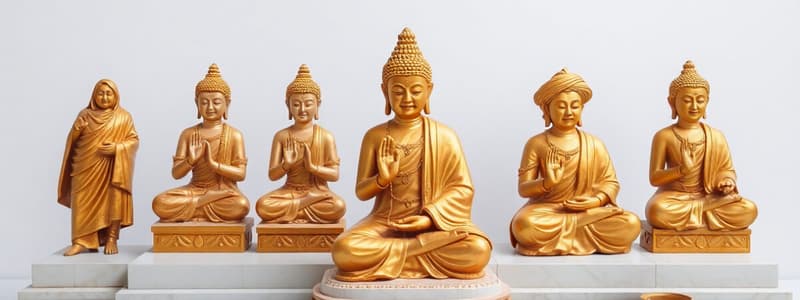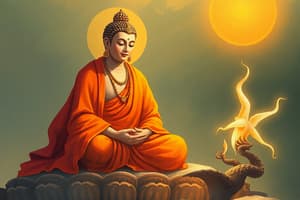Podcast
Questions and Answers
Which religions are considered to be the three pillars of the Indic religious tradition?
Which religions are considered to be the three pillars of the Indic religious tradition?
- Hinduism, Jainism, and Buddhism (correct)
- Buddhism, Jainism, and Sikhism
- Jainism, Sikhism, and Zoroastrianism
- Hinduism, Buddhism, and Sikhism
What was the primary rationale for the emergence of Buddhism and Jainism in India?
What was the primary rationale for the emergence of Buddhism and Jainism in India?
- As alternatives to Brahmanic/Hindu philosophy (correct)
- To unify various regional practices under one religion
- To establish a monotheistic belief system
- To promote the teachings of Hindu deities
Which of the following best describes the relationship between Jainism, Buddhism, and Hinduism?
Which of the following best describes the relationship between Jainism, Buddhism, and Hinduism?
- They share a common origin and beliefs but differ in practices. (correct)
- They represent distinct belief systems without any influence on one another.
- They are completely unrelated and emerged in different regions.
- They arose as competing religions with no shared history.
Which statement is true regarding the origins of Buddhism and Jainism?
Which statement is true regarding the origins of Buddhism and Jainism?
What is a common feature of Buddhism and Jainism within the context of Indian religions?
What is a common feature of Buddhism and Jainism within the context of Indian religions?
Flashcards
Major Indian Religions
Major Indian Religions
Buddhism, Jainism, and Sikhism are three major religions that emerged in India as alternatives to Brahmanic/Hindu philosophy.
Indic Religious Tradition
Indic Religious Tradition
The 'Indic' umbrella term encompasses Hinduism, Buddhism, and Jainism, representing three major pillars of ancient Indian religious thought.
Alternative to Brahmanic/Hindu Philosophy
Alternative to Brahmanic/Hindu Philosophy
Buddhism, Jainism, and Sikhism originated in India as alternatives to the traditional Brahmanic/Hindu beliefs and practices.
Classical Formulation
Classical Formulation
Signup and view all the flashcards
Buddhism and Jainism
Buddhism and Jainism
Signup and view all the flashcards
Study Notes
Indian Religions: Origin and Relationship
- Buddhism, Jainism, and Sikhism are alternative Indian religions to Brahmanic/Hindu philosophy.
- Buddhism and Jainism, along with Hinduism, are considered the three pillars of Indic religious tradition.
Studying That Suits You
Use AI to generate personalized quizzes and flashcards to suit your learning preferences.




